You are here: Funding your self-build
A beginner’s guide to self-build mortgages.
When building your own dream home there are two major costs: the plot and the construction itself. In addition, self-builders need money for professional services such as architect fees, site surveys, legal fees, stamp duty, self-build insurance and more. How you finance your self-build will depend on your individual circumstances. The funds may come from equity in your existing home, savings, a self-build mortgage or a mixture of all three. Here we look at self-build mortgages.

Traditional vs self-build mortgage
Perhaps surprisingly you don’t need vast savings to build your own home. It’s possible to borrow up to 95% of your land costs and 95% of your build costs with a relatively small deposit, according to BuildStore, which specialises in services for self-builders, including mortgages. You’ll probably need to find a specialist self-build mortgage provider as relatively few high street banks offer finance for those building their own homes.
The key difference is that money is released in stages rather than all at once as happens when you buy a property. These stages reflect the progress and increasing value of the land from securing detailed planning permission through to digging the foundations and final fix.
Arrears vs advance mortgages
There are two different types of self-build mortgage available; money can either be released in arrears after each stage of the build is completed or in advance before work begins. Advance mortgages can be a better option if don’t have lots of savings and don’t want to sell your current home before your new build is finished. It ensures you will have money to pay for labour and materials at each phase of the build. That said, the rates can be higher than an arrears type mortgage.
If you have access to large amounts of cash to finance some of your self-build home, you may prefer an arrears mortgage. A specialist mortgage advisor will find the most suitable product for your individual circumstances.
For a brick and block construction, funds are typically released at these key stages: -
- Purchase of land with the minimum of outline planning permission
- Preliminary costs & foundations
- Wall plate level/eaves height just before the roof trusses are added
- Wind and watertight roof
- First fix and plastering
- Second fix to certified completion.
Cost based vs valuation-based mortgages
Depending on your mortgage, your stage payments will either be guaranteed based on your project costs or interim valuations of the work completed to date. Valuation-based mortgages can be risky as the release of the stage payments depend on work adding sufficient value to the plot to trigger release of the funds. A valuation-based mortgage can also be affected by market conditions, valuer’s comments and quality of workmanship.
Under a cost-based mortgage, borrowers receive their money in guaranteed payments at the beginning of each stage. Cost-based mortgages give more peace of mind, says BuildStore. It’s essential that your estimated build is realistically costed, ensuring sufficient funds are in place at each stage of the build or you might run out of money.
Are interest rates higher for self-build mortgages?
Interest rates are typically higher for self-build mortgages compared to a conventional mortgage for a house purchase because there is more risk for the lender during construction. The main risk, obviously, is that you won’t finish the project and the lender will take possession of an unfinished property. For instance, at BuildStore, mortgage rates are between 3.99% and 5.99% (prices correct June 2022). Mortgage rates are on the increase generally, so it pays to shop around to find the most competitive rate. When the building is habitable, some mortgage providers allow borrowers to switch to a lower rate of interest, so it’s worth looking for this offer.
How much can I borrow with a self-build mortgage?
As with any mortgage, the amount you can borrow will vary with your individual circumstances. Lenders will assess your income and outgoings to calculate how much they are willing to lend you to make sure it’s affordable. The main difference is the lending is not limited by the plot or property’s current value.
You can typically borrow between 70 - 85% of land and building costs from specialist providers, for example Ecology Building Society, Earl Shilton Building Society and Dudley Building Society. A few providers offer up to 95-100% of construction costs. Some lending institutions do not lend on land, but they will provide mortgages during the build phase.
Lenders will require a detailed breakdown of costs, such as land purchase, professional fees, site preparation and/or demolition and construction costs. All the design and construction will need to comply with the current Building Regulations. Some lending institutions may request that a qualified quantity surveyor works out the build costs.
Do I have to sell my current home before my new build is finished?
This hinges on how much savings you have and how you choose to fund your building project. If you opt for an arrears payment mortgage, then you will need enough money in the bank for a deposit of between 15% and 25% of the land cost plus cash to pay for the early stages of the build. If you don’t have a lot of savings, you may choose to sell your current home to release equity.
If you don’t want to sell-up and move into temporary rented accommodation, then advance payments may be the better option. Getting stage payments before key stages of the build means cash flow should not be a problem so you can continue to live in your current home until your new home is finished. No caravan on site or costly furniture storage, may make this an appealing option. Another option is a bridging loan.
Reclaiming VAT
One of the benefits of building a new home is that you can apply for a VAT refund on building materials from HM Revenue and Customs (HMRC). Be aware that you can only make one claim for a VAT refund under the DIY housebuilders’ scheme, so keep all your receipts in a safe place. The rules state you can reclaim VAT on building materials that are part of the building and can’t be removed. This means you can reclaim VAT on timber flooring but not carpets, fitted furniture or some electrical and gas appliances. Nor can you reclaim VAT on professional fees, such as architects or surveyors.
The Community Infrastructure Levy (CIL) is a planning charge on building new homes. The aim is to provide funds for local authorities to deliver infrastructure, such as new roads and schools. The good news is self-builders can apply for an exemption from CIL. But you will need to fill in the relevant paperwork (Form 7: Self Build Exemption Claim Form Part 1 and Part 2) with supporting evidence and submit it to your local planning authority. The exemption must be granted before building work starts or it might be chargeable.
Finding the best self-build mortgage can be daunting. It’s a good idea to find a specialist mortgage advisor who is familiar with the process of building your own home to find the most suitable product for your unique circumstances.
If you are looking to make some home improvements, you may find some of these services useful
Building Regulations
Find details of local experts who can help with Building Regulations
Builders
Find local help with a building project
Architectural Design Services
Find local Architectural Design experts
Structural Inspections
Find an expert to carry out a structural inspection
Building Surveys
I want a local surveyor to do a Building Survey for me
Choose which Architectural service you require
If you are not sure which service you require, check out the options available...


